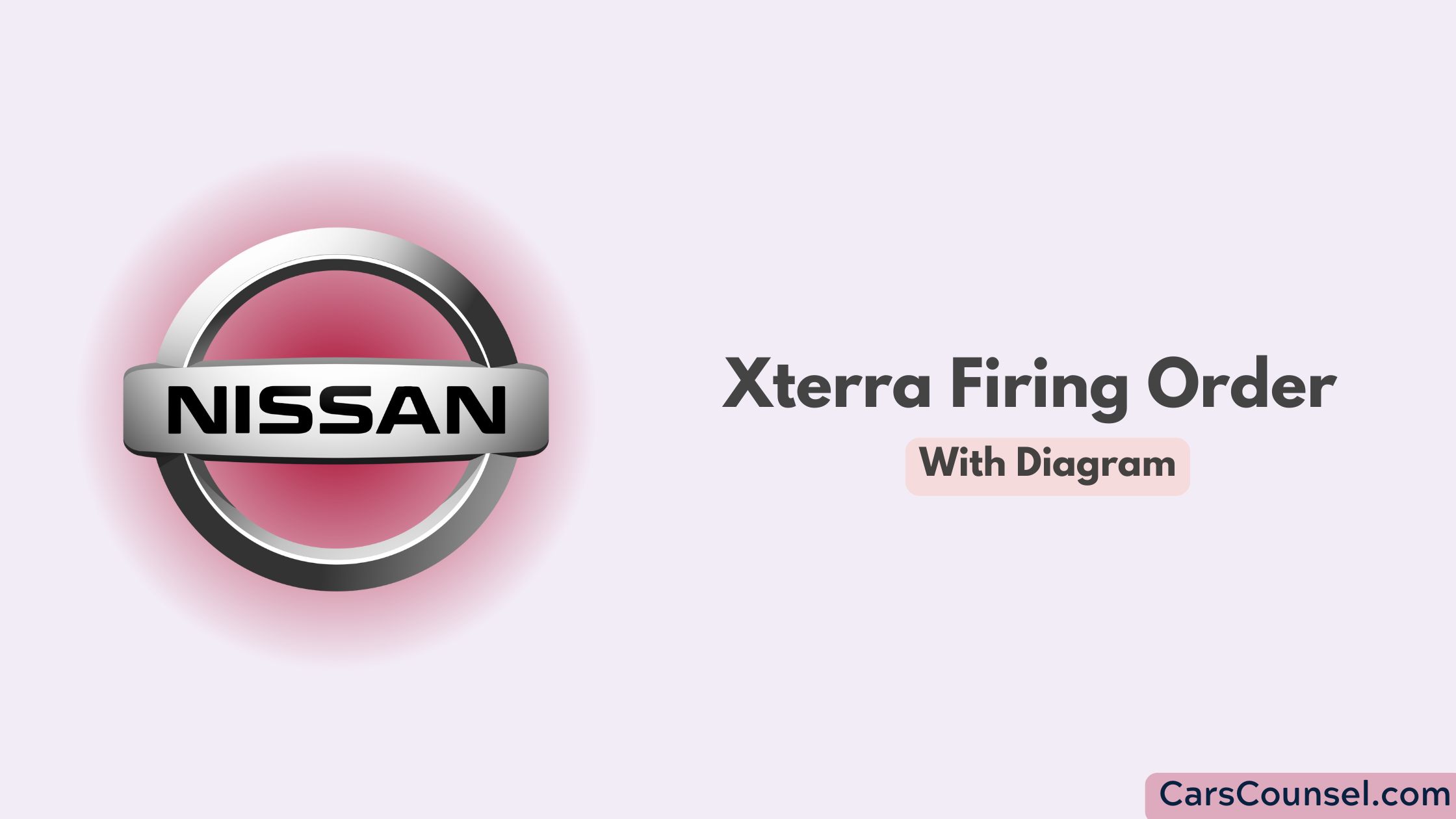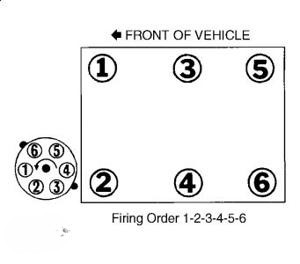The Nissan Xterra, a versatile and rugged SUV, has been a popular choice for outdoor enthusiasts and off-road adventurers. Powered by robust engines like the VG33E (3.3L V6) or VQ40DE (4.0L V6), the Xterra delivers dependable performance.
A critical aspect of its operation is the firing order, the sequence in which the engine’s cylinders fire to generate power efficiently and smoothly.
This article provides an in-depth explanation of the Xterra firing order, why it’s important, and how to maintain and troubleshoot it effectively. Whether you’re a mechanic, an Xterra owner, or a curious enthusiast, this guide is tailored to help you understand this vital aspect of engine operation.

Quick Navigation
The Xterra Firing Order
The firing order for both the VG33E and VQ40DE engines is: 1-2-3-4-5-6

How the Firing Order Works
- Cylinder 1 Fires First: Located on Bank 1, closest to the front of the engine.
- Cylinder 2 Fires Second: Located on Bank 2, also closest to the front.
- Cylinder 3 Fires Third: Middle cylinder on Bank 1.
- Cylinder 4 Fires Fourth: Middle cylinder on Bank 2.
- Cylinder 5 Fires Fifth: Rear cylinder on Bank 1.
- Cylinder 6 Fires Sixth: Rear cylinder on Bank 2.
This sequential pattern alternates between the two banks of cylinders to maintain smooth operation and balanced combustion.
Why Nissan Uses the 1-2-3-4-5-6 Firing Order
The 1-2-3-4-5-6 firing order is specifically designed to optimize the performance of the V6 engine. Here’s why it works:
- Balanced Combustion: Alternating firing between banks reduces vibrations and promotes stability.
- Heat Distribution: Prevents overheating by spacing out combustion events across all cylinders.
- Crankshaft Compatibility: Matches the crankshaft’s design, ensuring consistent torque delivery.
- Efficiency: Improves combustion timing, enhancing fuel economy and reducing emissions.
What Is a Firing Order?
The firing order is the sequence in which an engine’s cylinders ignite their air-fuel mixture. This controlled combustion generates power to drive the pistons and rotate the crankshaft. In a V6 engine like those found in the Xterra, the firing order is carefully designed to optimize performance and balance.
Why the Firing Order Matters
- Smooth Operation: Prevents excessive vibrations and ensures stable engine operation.
- Efficiency: Optimized firing improves combustion, fuel efficiency, and emissions.
- Durability: Distributes stress evenly across the crankshaft and internal components.
- Performance: Ensures consistent torque delivery for smooth acceleration.
Overview of Nissan Xterra Engines
The Nissan Xterra has been equipped with two primary V6 engine configurations across its production years:
- VG33E (3.3L V6): Found in earlier models, this engine is known for its reliability and straightforward design.
- VQ40DE (4.0L V6): Found in second-generation models, it provides more power and advanced features.
Both engines share a similar V6 layout, with six cylinders arranged in a 60-degree “V” configuration, making them balanced and compact for an SUV platform.
Key Features of Xterra Engines
- V6 Configuration: Six cylinders divided into two banks of three.
- Dual Overhead Camshafts (DOHC): Improves airflow and valve timing.
- Electronic Fuel Injection (EFI): Ensures precise fuel delivery.
- Cylinder Numbering:
- Bank 1: Cylinders 1, 3, 5 (driver’s side in U.S. models).
- Bank 2: Cylinders 2, 4, 6 (passenger’s side in U.S. models).
Identifying the Firing Order
Understanding the cylinder layout and ignition system is crucial for verifying or setting the firing order.
Cylinder Numbering
The cylinders are numbered as follows:
- Bank 1 (Driver’s Side): 1, 3, 5.
- Bank 2 (Passenger’s Side): 2, 4, 6.
Ignition System
The Xterra uses an electronic ignition system, eliminating the traditional distributor. A coil-on-plug or coil pack setup ensures that each spark plug fires at the correct time, governed by the engine’s electronic control unit (ECU).
Symptoms of an Incorrect Firing Order
An incorrect firing order can cause noticeable performance issues. Identifying these symptoms can help prevent further damage.
Common Symptoms
- Engine Misfires: Uneven power delivery due to incorrect spark timing.
- Rough Idling: Excessive vibrations or instability when idling.
- Power Loss: Reduced acceleration and overall performance.
- Backfiring: Combustion occurs in the intake or exhaust system due to improper timing.
- Increased Fuel Consumption: Inefficient combustion leads to higher fuel usage and emissions.
Diagnosing and Fixing Firing Order Problems
If you suspect a firing order issue in your Xterra, follow these steps to diagnose and resolve the problem:
Diagnostic Steps
- Inspect Ignition Coils: Ensure each coil is functioning correctly and connected to the appropriate cylinder.
- Verify Spark Plug Wires: For older models with distributor caps, ensure spark plug wires are routed correctly based on the 1-2-3-4-5-6 firing order.
- Use a Diagnostic Scanner: Check the ECU for error codes related to misfires or ignition timing.
- Perform a Compression Test: Verify that all cylinders have adequate compression to support proper firing.
Fixing Common Issues
- Reconnect Ignition Components: Ensure coils or wires are correctly installed and routed.
- Replace Faulty Parts: Install new spark plugs, ignition coils, or wires if they are damaged or worn.
- Update the ECU: Reflash or reset the ECU if software issues are causing ignition problems.
- Inspect the Timing Chain: Check for slack or misalignment that could affect timing.
Preventative Maintenance for Firing Order Reliability
Maintaining the correct firing order is essential for the longevity and performance of your Xterra engine. Follow these preventative tips:
Regular Inspections
- Check spark plugs and ignition coils for wear or damage.
- Inspect timing components, including chains and guides, for proper alignment and tension.
Replace Components as Needed
- Replace spark plugs and ignition coils at intervals recommended by Nissan.
- Use high-quality OEM parts to ensure compatibility and reliability.
Monitor Engine Performance
- Pay attention to signs of misfires, rough idling, or power loss.
- Use a diagnostic scanner to check for error codes that could indicate firing order issues.
Engines with Similar Firing Orders
- 2014 Nissan Pathfinder Firing Order
- Nissan Murano Firing Order
- 2006 Nissan Altima Firing Order
- KA24DE Firing Order
- ZD30 Firing Order
FAQs About the Xterra Firing Order
Can I Change the Firing Order?
No, the firing order is determined by the engine’s design and crankshaft configuration. Altering it would require extensive mechanical modifications.
What Happens If the Firing Order Is Incorrect?
An incorrect firing order can lead to misfires, backfiring, power loss, and potential damage to internal components.
How Can I Verify the Firing Order?
Refer to the service manual, inspect ignition connections, and use diagnostic tools like a timing light or OBD-II scanner.
Is the Firing Order the Same for All V6 Engines?
While many V6 engines share the 1-2-3-4-5-6 firing order, some manufacturers may use different sequences based on engine design.
Conclusion
The 1-2-3-4-5-6 firing order is a crucial aspect of the Nissan Xterra’s VG33E and VQ40DE engines, ensuring smooth operation, balanced power delivery, and efficient combustion. Understanding and maintaining this sequence is essential for keeping your Xterra running reliably, whether you’re tackling rugged trails or navigating city streets.
By following proper maintenance practices, using high-quality parts, and addressing issues promptly, you can enjoy the legendary reliability and performance of the Nissan Xterra for years to come. Whether you’re a DIY enthusiast or a professional mechanic, mastering the firing order is a key step in maintaining this capable SUV.

